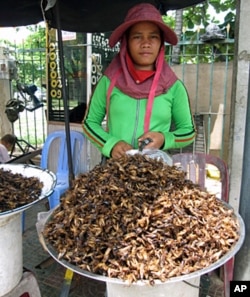Most people try to keep insects out of their kitchens. But many of the creepy-crawlers are edible and quite nutritious. That is, if you can get past the idea of eating something usually considered a pest. In Laos, that is not a problem, since nearly everyone likes to snack on edible insects. Now, the United Nations is encouraging even more bug-eating there to solve the country's high rates of child malnutrition.
Listen to VOA Agriculture Reporter Steve Baragona discuss his insect diet:
Larrisa Brunn of the U.N. Food and Agriculture Organization admits the anti-hunger fight has entered somewhat unfamiliar territory.
"We've done a nationwide survey here in Laos and it showed that nearly 95 percent of the Lao population eats insects. So this shows how insects are part of the diet here and part of the culture, part of their nutrition," Brunn said. "So it's not like we are introducing something new, on the contrary we are working with the existing food base."
Researchers estimate that worldwide, there are more than 1,700 edible insects. In Laos, grasshoppers and crickets are among the most popular, but locals also eat beetles and grubs and insect larvae. The insects are rich in protein and fat, as well as essential vitamins like iron and calcium. While some bugs can be eaten straight from the field, it is tastier and safer to prepare them Brunn says.
"Just like any meat, they are normally cooked. I'm sure there are some you can eat live, but here in Laos traditionally they are cooked. The normal way they will be served is quickly deep fried but I've also tasted very traditional recipes which can be made with fish and other meats with insects added. They can be flavored as well with cheese. So there are many ways insects can be eaten."
Bug eating has been popular for hundreds of years in the region. The FAO is hoping to capitilize on that trend by raising the income of local bug collectors and increasing the yield of bug farmers. That, in turn, could lead more people to rely on the critters for the daily nutrition. Brunn said the FAO is working with the Lao government and insect aficionados to improve their yield and make it sustainable.
"For the past year, we've had a small pilot which where we worked with some farmers in Vientiane, the capital of Laos, trying out insect farming and now in May we had a bigger two year project approved where we will be working with a bigger group of farmers and the main aim being on nutrition, because insects are highly nutritious and part of the culture in Laos. They are tied to the diet. They can provide income opportunity and also diversity in the project."
As for people who may be squeamish about eating a fried grasshopper or termite, according to the FAO's Brunn, taste is not necessarily the biggest issue.
"In the West, I know in North America and Europe insects are not part of the diet like they are in Southeast Asia, Africa and Latin America. So for us, myself a European, it can be a repulsive experience once you first try it." Brunn points out, "Somebody just said to me when you eat a cow, you don't put the whole animal on the table. So we have to transform crickets for example to a cricket hamburger. You may actually like the flavor and find them delicious."
Part of the FAO's bug campaign in Laos is to encourage traditional insect eating habits and reassure people that swallowing a silkworm is not something to be embarrassed or ashamed of. Brunn said the bugs are an important part of culture, and a potentially important contribution to a diverse and healthy diet.













